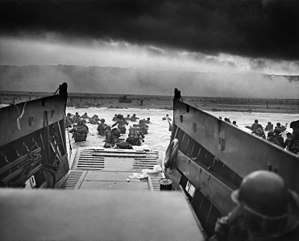Into the Jaws of Death
Taxis to Hell – and Back – Into the Jaws of Death is a photograph taken on June 6, 1944, by Robert F. Sargent, a chief photographer's mate in the United States Coast Guard. It depicts U.S. Army's 1st Infantry Division soldiers disembarking from an LCVP (Landing Craft, Vehicle, Personnel) from the U.S. Coast Guard-crewed USS Samuel Chase at Omaha Beach during the Normandy Landings in World War II.[1]

Original caption: "American invaders spring from the ramp of a Coast Guard-manned landing barge to wade those last perilous yards to the beach of Normandy. Enemy fire will cut some of them down. Their 'taxi' will pull itself off the sands and dash back to a Coast Guard manned transport for more passengers."
The photograph
The photograph was taken by Chief Photographer's Mate Robert Sargent during the troop landing phase of Operation Neptune, the naval component of the Operation Overlord Normandy landing commonly known as D-Day.
The photograph was taken at 7:40 AM local time. It depicts the soldiers departing the Higgins boat and wading through waist-deep water towards the "Easy Red" sector of Omaha Beach.[2]
The image was one of the most widely reproduced photographs of the D-Day landings. The original photograph is stored by the United States Coast Guard Historian's Office.[2]
Background
Neptune was the largest combat operation performed by the United States Coast Guard in American history.[2]
The Higgins boat depicted in the photograph had departed from the attack transport USS Samuel Chase about 10 miles (8.7 nmi; 16 km) from the coast of Normandy at around 5:30 AM. Waves continuously broke over the boat's square bow, and the soldiers inside were drenched in cold ocean water.[2]
In all, Samuel Chase lost six landing craft on D-Day; four foundered near the beach, one was "impaled" by a beach obstacle, and another was sunk by enemy gunfire.[2]
Origin of the phrase
The phrase "into the jaws of Death" in the photograph's title comes from a refrain in "The Charge of the Light Brigade", an 1854 narrative poem by Alfred, Lord Tennyson about the Charge of the Light Brigade at the Battle of Balaclava during the Crimean War.[3]
In popular culture
The image was evoked in the 1998 Hollywood film Saving Private Ryan,[4][5] and appears on the cover of Stanley Lombardo's 1997 English translation of the Iliad as a symbol of the universality of war.[6] The picture was also rendered on the 2017 Call of Duty game Call of Duty: WWII.
References
- Price, Scott T. "U.S. Coast Guard at Normandy". U.S. Coast Guard Historian's Office. Retrieved 3 January 2012.
- Young, Stephanie. "Into the jaws of death: U.S. Coast Guard-manned landing craft at Normandy". United States Coast Guard. Retrieved 6 March 2015.
- "The Charge Of The Light Brigade". Alfred, Lord Tennyson. nationalcenter.org. Archived from the original on March 2, 2015. Retrieved February 28, 2015.
- Shields, Mark (August 3, 1998). "'Ryan' recalls a war that was 'good' because it was democratic". The Free Lance–Star. Creators Syndicate.
- Ritzenhoff, K.; Kazecki, J. (2014-08-07). Heroism and Gender in War Films. Springer. ISBN 9781137360724.
- Mendelsohn, Daniel (July 20, 1997). "Yo, Achilles". The New York Times.
External links
